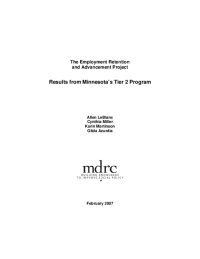Results from the Minnesota Site in the Employment Retention and Advancement Project
Despite advances in the development of programs to help welfare recipients find jobs, a significant portion of the welfare caseload remains on the rolls for long periods without working. This report evaluates the effectiveness of a program in Minnesota, the Tier 2 program, designed to assist those recipients. It was evaluated as part of the Employment Retention and Advancement project, which is testing 15 programs nationwide. The project is being conducted by MDRC, under contract to the Administration for Children and Families in the U.S. Department of Health and Human Services, with additional funding from the U.S. Department of Labor.
The Tier 2 program operated in Hennepin County, which includes the city of Minneapolis, and was built on the services provided by the county’s preexisting welfare-to-work program, the Tier 1 program. Tier 2 differed from Tier 1 as follows: (1) case managers worked with smaller caseloads; (2) clients received in-depth assessments to uncover problems that affected them and their families; and (3) it placed greater emphasis on referring individuals to services to address barriers to employment and placing recipients who could not find work in supported employment positions (whereby participants worked for a wage in jobs supervised by program staff).
The Tier 2 program was evaluated starting in 2002 using a random assignment research design, whereby eligible individuals were assigned either to a program group, whose members were assigned to Tier 2, or to a control group, whose members remained in Tier 1. The Tier 2 program’s effects were estimated by comparing how the two groups fared over time.
Key Findings
- Although the Tier 2 program was well implemented, it did not increase clients’ use of services to overcome employment barriers, such as problems with mental health, substance use, or domestic violence, or their participation in most other program services. Tier 2 did not increase participation in education or training activities, but it did lead to small increases in job search activities and participation in supported employment.
- The Tier 2 program had little effect on participants’ employment, earnings, or public assistance receipt. The Tier 2 and Tier 1 groups had similar rates of employment over the follow-up period of one and a half years (about two-thirds of both groups worked at some point). Early on, the Tier 2 program led to a modest increase in employment — and a notable increase in employment among participants who had previous work experience — but these differences did not persist. The Tier 1 and Tier 2 groups had similar rates of Temporary Assistance for Needy Families (TANF) and food stamp receipt, and TANF receipt gradually fell over time at roughly the same rate for both groups. Toward the end of the follow-up period, rates of TANF receipt were somewhat higher for the Tier 2 group; longer-term follow-up will show whether this late effect persists.
These results are not the final word on the Tier 2 program, as MDRC plans to track employment outcomes for three years. The findings do, however, illustrate the persistent challenge of finding strategies to effectively assist individuals who receive cash benefits for long periods. They suggest that lowering caseloads may not be enough for programs to succeed. It may be that lower caseloads and increased staff-client interaction are more effective when clients are also participating in a fuller range of services that address their needs. These findings suggest that in-depth assessments need to be more effectively linked to mechanisms that facilitate referrals and promote service engagement.






